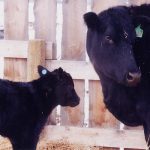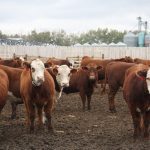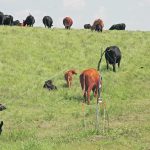The technology gender-types embryos before they hatch, avoiding the standard practice of euthanizing day-old male chicks
Most of us are familiar with salmonella bacteria as a potential cause of gastrointestinal disease in humans. The severe diarrhea, abdominal pain, fever, headaches and dehydration can cause serious consequences in people, especially in the elderly and young children. However, there are numerous strains of salmonella bacteria, and some of them are adapted to cattle […] Read moreStories by John Campbell, DVM, DVSC

Cache Valley Virus can be difficult to prevent in sheep flocks
In the past few weeks, Prairie Diagnostic Services in Saskatoon has had some confirmed cases of stillborn and aborted sheep fetuses diagnosed with Cache Valley Virus, a mosquito-borne disease. The virus is widely distributed in mosquito populations throughout North America and in parts of Central America. It was first identified in 1956 in mosquitoes collected […] Read more

Low cow herd pregnancy rates should be investigated
Many producers have finished or will soon finish pregnancy testing their cattle herds this fall. Anecdotally, it seems pregnancy rates are improved compared to the last few years, when many areas were affected by drought, and poor-quality feed affected body condition and pregnancy rates. This year it seems many herds have returned to normal levels […] Read more

Feed testing the first step in planning winter feeding program
It’s that time of year, when you will see lots of articles about the importance of feed testing. I would certainly agree that feed testing is an important step in planning winter feeding programs for our cow herds. However, it is just the first step of the process. We need to take the information from […] Read more

Caution needed when feeding brassica forages to cattle
Polycrops have become a more commonplace method of feeding beef cattle in Western Canada over the past number of years. They may also be known as intercrops, cover crops or cocktail crops but all involve a mixture of plant species that may range from three to more than 20 species. Polycrops can provide grazing when […] Read more

Veterinary medicine makes use of artificial intelligence
Artificial intelligence and machine learning are becoming part of everyday life very rapidly. From smart watches that track your sleep to apps on your smartphone that use artificial intelligence to provide information in seconds, AI is becoming more and more commonplace. My simplified understanding of AI is that this field of computer science is developing […] Read more

Study looks at modified live vaccine interference in calves
Vaccines for cattle can be categorized in several ways. We can categorize them by the pathogen that they are designed to protect the animal from (bacterial or viral), or we can categorize them by their route of administration (injectable or nasal). For viral vaccines, we also can split them into modified live or killed vaccines. […] Read more

Watch for copper, selenium deficiencies in beef calves
Weaned calves have a lot of changes to deal with around the time of weaning. They may be transported to an auction and then mixed with other sources of cattle into truckloads to go to a feedyard. On top of that, they are expected to adapt to a new ration and are often vaccinated and […] Read more

Lameness problems in bulls can affect their sperm quality
There’s nothing worse than having a sore foot. If you’ve ever had plantar fasciitis or some sort of foot injury, you know the pain can be truly debilitating. It can hamper mobility so much that everyday tasks seem daunting. Lameness in bulls can be just as debilitating. It is obvious that a lame bull will […] Read more

Lab testing discovers cause of unusual cattle diarrhea
I’ve talked to two different veterinarians this year who had each dealt with unusual cases of diarrhea and death in cattle. In one case, the affected cows and calves were on pasture in the fall and the other case involved Holstein-cross calves shortly after arrival in the feedlot. In both situations, affected animals initially presented […] Read more




